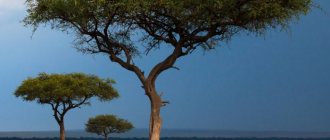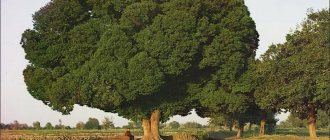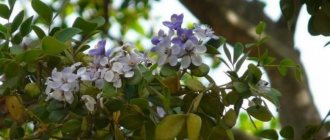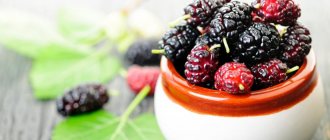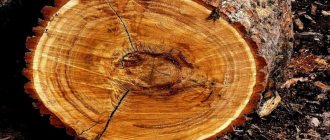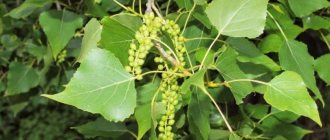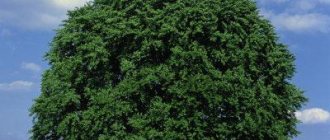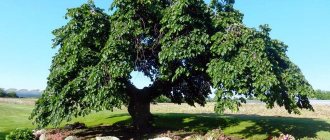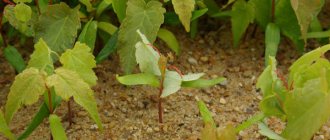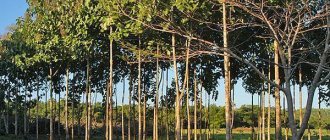The ancient giants of elms are plants that are difficult to imagine in miniature form. But thanks to complex long-term formation and careful care, these trees are also found among indoor plants today. The art of bonsai creates real living works of art from elm trees. Growing them in living rooms is not easy, but with diligent care, elms will become the pride of any collector.
Small-leaved elm bonsai. © artofbonsai
Elm tree, description
Elm (from Latin ulmus laevis) is compared to oak in its majesty and power.
This is a relict species, the lifespan of which trees goes back several centuries. The growing area of elm species is extensive; in Russia they are found in several subspecies; in addition, they can be seen in North America and Europe. This genus of trees is found both as single representatives and in mixed plantings. They also feel quite good in poor soils, but mostly grow on fertile lands. This type of tree grows upward even when there is not enough sun. At the same time, the growth rate of elm is very high. The growth per year is about 50 cm in height, and in trunk girth up to 0.3 meters.
A mature elm can reach 40 meters, but there are also species that resemble shrubs. The surface of the bark of a young elm is without roughness, light brown in color, and over time it becomes covered with vertical grooves. The root system of the tree is powerful, the roots penetrate to a depth of 30 meters with a trunk with a girth of 1.5 meters. But some species have their roots spread out rather than deep, covering vast areas.
Elm leaves differ significantly from other species in their elongated oval shape and jagged edges. Leaf size is from 4 to 20 centimeters. They are located alternately on the branches and are attached to them with short cuttings. In autumn they change color from green to red-brown and the crown quickly thins out.
The tree blooms in the spring, before it becomes overgrown with leaves. The inflorescences are small, yellow in color. Elm seeds are small winged nuts. They ripen in the last days of May, and the wind scatters them throughout the surrounding area. If the conditions are right, they can germinate within a few days.
Reproduction of small-leaved elm
Indoor elms are propagated only by cuttings. Regular pruning allows you to constantly obtain rooting material. Elm cuttings are traditionally treated with growth stimulants, planted in a nutritious, moist substrate at an angle and rooted in a warm place under a hood. Rooting is not a quick process, but young plants develop very actively. Formation begins after the elm has formed the third pair of leaves. The cuttings are planted in individual containers with control of the size of the root system immediately after rooting.
Where does it grow and when does it bloom?
Elm trees grow well in fertile soils and, with proper care, reach large sizes. However, in natural conditions they can easily tolerate drought and floods, and easily tolerate severe frosts. Most often, elms grow in the following areas:
- Western Siberia;
- Kazakhstan;
- Southern Urals;
- Caucasus;
- Volga region;
- European countries;
- Scandinavia.
The powerful crown of these trees traps dust well. It often serves as a protective fence as a living plant. A large crown with dense foliage can often be seen in many city parks and gardens. In their natural environment, elms are often found in deciduous forests, along the banks of lakes and rivers. They help create clean plantings.
The flowering period begins very early, in March - April. Small and inconspicuous flowers, collected in bunches in the leaves, are easily pollinated by the wind. The period of fruit ripening depends on climatic conditions. Most often they ripen in April - June. An adult tree begins to bear fruit at the age of 7-8 years.
general description
Elms appeared on earth millions of years ago; they can be classified as relict tree species. In the area they are more often found in mixed and deciduous forests and can grow solitary. They love fertile and alkaline soils, tolerate a lack of sunlight well, and are able to create dense shade thanks to their dense crown.
Young elms have light brown, smooth bark; with age it darkens and becomes covered with deep longitudinal furrows, becoming rough and thick. Mature trees of many varieties look powerful, growing up to 40 m in length, and the trunks of some specimens reach a diameter of 2 m. There are also shrub species. Tree roots grow to great depths, and in podzolic soils they branch widely to the sides. Elm leaves are very beautiful: rough or smooth, ranging in size from 4 to 20 cm, rich bright or dark green, three-toothed, pointed towards the edges or oval, lined with relief stripes from the center to the sides, arranged alternately, almost closely on short cuttings. On the branches they form a kind of lace thanks to the relief pattern. The shadow provided by the spreading wide elm crowns is almost not illuminated by the sun. The leaves fade very early, acquiring a red-brown color and falling off in early autumn.
The elm tree blooms and bears fruit in April, even before the leaves appear. Its flowers are dioecious, inconspicuous, collected in small yellowish bunches. The fruits are small nuts surrounded by lionfish. On trees they ripen already with the first onset of warmth - in May. Carried by the wind throughout the area, the fruits fall into the soil and sprout within a few days.
Because of their gnarled, furrowed bark, elms are often susceptible to insect pests and fungi.
Types of elms
Among all species of the Elm family, elm is the most widespread. It easily adapts to bad weather conditions and can withstand frosts down to minus 28 degrees. The most popular are the following subspecies of elm:
Ordinary
The common, or smooth, elm is widespread throughout the European part, Western Siberia, and the Caucasus. Depending on the fertility of the soil, tree trunks rise from 10 to 25 m, their diameter is up to 1.5 m in old specimens. In urban conditions and on soils poor in nutrition, such elms are much lower and thinner. The bark is dark brown, textured, rough, and may peel off in small scales. The shoots form a wide elliptical crown.
The leaves are up to 15 cm long and 10 cm wide, elongated, framed by sickle-shaped teeth. The front side is dark green, the back side is lighter, matte, slightly pubescent. Brown-violet small flowers bloom in April; after 7–12 days, small fruits with membranous lionfish are formed in their place. The common elm grows quite quickly, tolerates pruning well, and creates dense shade. It can be used for landscaping parks, alleys, and local areas.
Squat
Small-leaved, or squat, elm or simply elmovik lives up to its name. Compared to related giants, its maximum height is no more than 15 m, and often forms shrubby forms. Distribution territories: Transbaikalia, Far East. Elmovik has thin branches, leaves are rounded, jagged, unequal at the base, pointed towards the ends.
Size - about 4–7 cm. In spring, the foliage of the squat elm is soft green and leathery. In summer it gets dark. The inflorescences are small, yellowish-brown in color. Ilmovik does not like heavily shaded areas, preferring bright places, but it creates quite a thick shadow. It is unpretentious to soil composition and tolerates drought well.
Blade
One of the common Far Eastern species, due to the original shape of its large leaves resembling sharp blades, is often called split. It grows mainly in high mountain areas. The tree trunks reach 25 m in height, the crown is cylindrical and very dense.
Rough or mountain elm (Ulmus glabra)
Prefers fertile soil. Most often the plant can be found in mixed forests. Compared to other varieties, the bark of this elm is the smoothest. The height of the tree is about 40 m. The surface of the large green leaf plates is uneven.
Planting an elm hedge
Planting a tree will not be difficult, no additional conditions, no complex manipulations - just simple planting, prepared soil.
- The trees are quite large, so the crowns need a lot of space. You should also consider the height of the adult specimen. The average spacing is maintained at about a meter.
- Dig holes or one trench. If the fence is planned to be small, you can simply make holes, but if planting will be done en masse, it is much more convenient to plant all the seedlings in a single trench at once.
- The depth of the hole (trench) is approximately seventy centimeters; two-year-old seedlings have a fairly developed root system that cannot be damaged. You should not bend the roots; the bad ones are removed immediately to prevent rotting of the entire rhizome.
- The width of the trench is approximately half a meter. This size is quite enough to lay the roots.
- Unpretentious elms easily tolerate the lack of drainage. Moisture and dryness are normal growing conditions, so filling up the drainage is unnecessary red tape. The most helpful thing is to sprinkle the bottom with a little sand. Sandy soil dries the soil, conducts moisture well, removes excess water, preventing root rotting.
- After a little improvement of the bottom, you can place the seedlings themselves. It is important to plant potentially tall species strictly vertically, otherwise when the crowns “meet” later, they will greatly interfere with each other.
- The roots are covered with soil. It is better to add a little humus, although it is not necessary. An unassuming tree will do just fine without additional feeding.
- Then they fill the plant completely, trampling the soil a little.
- After planting, organize a constant watering system; it is especially important to water thoroughly for the first month while the rooting process is taking place. Ten liters per square meter is the optimal volume of water.
- The most favorable planting periods are June-July. This fact is quite rare, because most plants love spring or autumn planting, but elms prefer well-warmed soil.
- After planting is completed, the soil is mulched with peat or sawdust, covering the root space with a thick layer of about ten centimeters.
- The first pruning is carried out before the beginning of the growing season, until April.
- The first really serious pruning is done after the four-year mark of active rooting. Previously, dried shoots were simply cut off. The cut areas are lubricated with garden varnish, otherwise fresh cuts are very fond of fungal diseases and various wood bacteria.
- It is necessary to maintain a healthy appearance of the planting, otherwise attacks by spider mites, which are difficult to remove, are possible.
Elms are propagated by cuttings; one tree produces about ten cuttings, so you can save significantly by eliminating the purchase of seedlings. Among other things, the plant is a long-liver, capable of living for more than fifty years. There are certain species whose age exceeds five hundred, even eight hundred years. These long-livers, of course, are inhabitants of landscape gardening areas and botanical gardens, which can accommodate a gigantic tree and create the most necessary conditions. However, even ordinary garden plots become places for the active growth of tall, long-living species.
Garden varieties and types of elm with photos
Mountain elm or rough elm variety "Camperdownie" (Ulmus glabra Camperdownii). It is a picturesque low tree with a characteristic weeping crown in the form of an umbrella of hard shoots.
The height of "Camperdownii" is usually 2 - 2.5 m. After a few years, the width of the crown can reach 6 - 18 m. The leaves are large, hard, and numerous. In autumn they acquire a golden yellow color.
Weeping elm "Pendula" with a compact crown. Another low-growing variety of mountain elm with shoots that form a green tent. Trees prefer sunny places and fertile soils.
The same type of variety from the Dutch (formerly "Monstros"). A rare dwarf elm, one of its smallest forms. Grows as a compact, round bush. At maturity, its size is only 40 cm in height and 40 cm in width.
The leaves are large, about 4 cm, which is special for this small plant. The unique appearance and shape of the variety fits perfectly into compositions of low-growing shrubs, coniferous crops and cereals.
Cork elm or elm (U. Minor). Synonyms: small, field or hornbeam elm. In nature, it is a powerful, long-lived tree that grows throughout Europe. Three varieties have become widespread in horticulture.
"Argenteovariegata". The decorative nature of elm lies in its variegated foliage with white and cream spots. It grows slowly. The height of an adult tree reaches 10 meters, and the width of the crown is 5 meters.
Typical requirements for this species are fertile, moderately moist soil, a sunny location, which enhances the brightness of the foliage color.
In the garden, “Argenteovariegata harmonizes well with other variegated plants, although such original varieties are usually planted separately to create a strong accent in the garden design.
"Webbiana" is an ornamental elm with a unique type of foliage. Throughout the season, the leaves of this tree are slightly curled. It seems that the tree is drying out or sick.
Meanwhile, this is a feature of the varietal form. Produces a wide crown of several large, strong branches. The maximum height is about 4-5 meters. It grows well in moist and fertile soil, but due to the structure of the foliage, which reduces water evaporation, the variety is resistant to prolonged drought. The most popular and incredibly beautiful variety of this species is “Jacqueline Hiller”. Compact, low and slow growing tree. Its decoration is small, densely spaced, slightly curled, dark green leaves about 2-3 cm long.
Young leaves are pink. The varietal form is grown both on a standard and in the form of a bush. Can grow in any light. The variety is resistant to diseases and low temperatures, and can grow in fertile and poor soils. After 10 years, its height reaches 1.8 m.
White or American elm (Ulmus americana). This tree is incredibly hardy; unlike many ornamental varieties and hybrids, it can withstand temperatures down to minus 42 °C! Unfortunately, this species is susceptible to Dutch disease.
Variety "Beebes-Weeping"
The tree has a high, slightly lacy crown. An interesting fact is that the American elm is not sensitive to photoperiod length - it will continue to grow throughout the fall, despite the shortening days, until its growth is stopped by frost.
Squat elm (U. pumila) or small-leaved elm (Ulmus parvifolia) is native to East Asia. A small evergreen shrub or tree that is ideal for creating a bonsai style. The leaves are small, some varieties have small, shiny leaves.
Highly decorative variety "Geisha". In spring the leaves are white-green and white-cream, but after a short time they turn dark green with cream-colored teeth along the edges. A tree with a picturesque crown, some of the branches grow vertically, and some hang slightly to the ground, often sold as a trunk.
The variety is completely frost-resistant, although it is not recommended to plant it in places exposed to strong winds. Requires fertile, moist soils and plenty of sun, which affects the bright color of the foliage. The maximum height is about 3 meters. Looks great as a tapeworm around the house or on the lawn.
"Hokkaido" is a dwarf Japanese variety. In eastern countries it has gained great popularity as an excellent material for forming elm bonsai. It grows in the form of a bush with a dense, branched, oval crown. Height is about 50-70 cm.
The shoots are thin, intricately curved, densely leafy. Thanks to the form of shoot growth, this tree is decorative not only during the season, but also in winter! It has very high tolerance to different types of soil, although it grows best in fertile and moderately moist soils in full sun.
The variety is completely frost-resistant, but it is better to grow it in places protected from the cold winter wind. In the garden it looks great in rock gardens, on alpine slides, along paths. This planting allows you to appreciate all the advantages of the varietal form.
A very famous hybrid in horticulture is the Dutch elm (Ulmus x hollandica) of the “Wredei” variety. A low tree with a narrow conical or cylindrical crown.
The shoots are densely leafy. The leaves are wide, tightly adjacent to the shoot. In spring they are light yellow and in summer they turn golden green. The leaf shape is slightly curled. The tree grows slowly and after 10 years reaches 4 m in height.
The plant has low soil requirements and is frost-resistant. The recommended variety is excellent for color compositions; it looks especially beautiful next to varieties of trees and bushes with green and purple foliage (barberry, elderberry, scarlet).
The variety can grow in sun and partial shade, is drought-resistant, but when planted in the sun it requires regular watering.
Planting and caring for elm
Growing an elm tree in your yard is not particularly difficult.
You can plant it with seeds, they sprout quickly.
- They are collected when the tree has flowered and placed on damp cotton wool; the seed is immediately treated with a fungicide.
- This treatment will protect the future plant from the fungus, which will be difficult to remove once it appears.
- After a couple of days, the sprouted seed is transplanted into a container with soil; black soil is best; the plant will germinate more safely in it.
- If there is no black soil, you can use humus with soil; the soil should be moistened and loosened.
- The seeds are planted to a depth of about two centimeters.
- There should be a distance of twenty-five centimeters between planted seeds.
- The top soil is covered with moss or hay, you can again use cotton wool.
- The soil needs to be watered every day, and after ten days shoots will appear and it will be possible to remove the material that covered the soil.
It is recommended to expose young shoots to sunlight.
Seeds are germinated at the end of spring, which is the most active growth of all plants.
In good weather, with little wind, the shoots are left on the balcony or in the garden.
For your information. In the first year of life, seedlings grow twenty centimeters, and the next year they can be planted in open soil.
Root system
The elm root system is so powerful that it can successfully compete even with oak roots. Not only the main taproot, through which the tree receives its main supply of nutrients, penetrates into the soil to a sufficiently great depth, but also the lateral ones. It is this property that makes it possible to ensure significant stability of the tree even in strong winds.
For example, when planting on shelterbelts, they restrain the main gusts of wind, allowing you to obtain full-fledged crop yields, the ripened seeds of which practically do not fall to the ground.
Care and breeding
Reproduction of elms occurs mainly by seeds. The tree can also be propagated by shoots. If the seeds are placed in an airtight container, they will be able to retain their germination properties for 2 years. After the seeds ripen, they are planted after two weeks.
The plant does not require preliminary soil preparation. They must be laid out in the soil at a distance of 20-30 cm from each other, covered with a layer of soil and watered abundantly. During the first month, the seeds are watered regularly and abundantly. In very hot weather, it is advisable to cover the seeds with film until the first shoots appear. As the young tree grows, it will be easy to tolerate excess moisture or drought. Young shoots grow well even in the shade.
Before planting seeds or seedlings, you should consider the growth rate of the plant. After 2-3 years, the tree can shade other plantings. It is known that elms have a negative effect on grapes, so they should not be planted nearby.
Reproduction
Elm propagates primarily by seeds, but cuttings can also be rooted. To do this, cut the cuttings in late autumn and treat them with special means to stimulate root formation. After this, it should be placed in water and wait for roots to appear. You can plant the cuttings after the first roots appear. For planting, special loose and nutritious soil is required.
Diseases and pests
Typically, elm is affected by elm springtail, scale insects, and leaf beetles. It is easy to identify a disease in a tree; its crown dries out and growths appear on the bark. To combat parasites, treatment with liquid copper sulfate, insecticides and fungicides is used.
Young trees are easier to get rid of diseases. Old elms are difficult to get rid of parasites, especially fungi. That is why the use of antifungal agents is recommended at the planting stage.
Subtleties of care
Caring for small-leaved elm will not be difficult, just follow these rules:
- Temperature and lighting. If the plant is planted in a sunny area, it will have a lush and dense crown. More beautiful forms can be achieved by placing the elm in the shade. The plant is not afraid of winds and drafts. If your elm grows in a pot, it is recommended to take it out into the fresh air during the summer. In the cold season, care consists of timely watering and sufficient light.
- Watering. The plant cannot be flooded, nor should it be kept dry. Moderation is what the tree likes. Watering speeds up the growing season. After pruning, watering is slightly reduced, but the tree is not allowed to dry out.
- Feeding. Organic matter is used as fertilizing. The solution is applied to the soil once every 2 weeks. Fertilizer will keep the elm healthy and full of vibrant greenery. If you want your tree to be full of bright colors in the fall, stop feeding in August. Fertilizer application will have to be restored if the shoots begin to develop incorrectly due to a lack of nutritional components.
- The soil. The choice of soil must be approached very carefully; its further growth and development depends on this. It should retain moisture and be rich in organic matter. The best option is acidic soil. For bonsai, you can prepare a mixture of crushed stone (sand) in equal quantities with rotted compost.
- Pruning and crown formation. Light pruning of branches and shoots is carried out at the end of winter, giving the plant the desired shape. Also, the shoots are shortened during the growing season (it’s good if the cut is above the node). This way the crown will grow. Next, the shoots will only need to be trimmed a little so that the elm does not lose its shape. Light is important for a tree, so from mid-winter to mid-spring the crown can be thinned out a little, removing branches without leaves. Every few years it is necessary to cut off the foliage.
It is important to keep the tree clean, for this:
- Periodically wipe the foliage from dust to improve air circulation.
- Remove fallen leaves that fall on the ground.
Transfer. There is no need to replant the elm often; once every 3 years, or even 5 years, is enough. The procedure is carried out in the spring, while removing a third of the root system. Severely outdated roots are removed completely.
But young trees need to be replanted annually. The procedure goes as follows:
- Transplantation is carried out in winter or early spring. The pot is chosen larger than the previous one, the composition of the soil remains the same.
- Before planting a tree in a new pot, place some pebbles on its bottom. In this way, it will be possible to avoid putrefactive processes of the root system in the soil.
- Before transplanting, it is permissible to shorten the roots, but only slightly. If the roots are cut very short, the tree will be stressed, which will adversely affect its further development.
- After transplanting, the bonsai is well watered and placed in a shady place for several weeks (from 2 to 4).
Elm meaning and uses
It is difficult to overestimate the importance of elm. Its bark, fruits and leaves are successfully used in folk medicinal recipes. It is important to talk to your healthcare professional before using elm in the treatment of various diseases. Therapy has side effects and contraindications.
Decoctions based on bark and leaves help reduce inflammation, have antibacterial properties, and help heal damage. The extract is used for the treatment of kidney, heart, blood vessels, thyroid gland, etc.
A decoction is useful for throat diseases. So, if you have a sore throat, it is recommended to gargle with it. Tea from the leaves is used for constipation. In case of hemorrhoids and kidney diseases, baths with elm bark are recommended. The tincture is used to get rid of skin rashes.
Elm wood is often used in industrial production due to its excellent properties. Elm wood is often used as an alternative to expensive wood species. Its texture allows you to imitate valuable varieties, with a fairly light color. Mahogany connoisseurs love elm. Elm is used to make furniture for the home and is also used to make paintings.
The density of elm wood is very high, approximately 600 kg/m3. The cut of wood has a beautiful texture, which makes it suitable for use in carpentry. It is resistant to rotting processes and is difficult to split and saw. However, it behaves very well when polished.
In the old days, elm was also used in carpentry workshops, and paint was made from its bark. Without taking into account the pests that attack the tree, it is often planted in parks, around the city, and in social institutions.
Use of elm in economic activities
The average lifespan of elm is 80-120 years. 400-year-old specimens are known.
Elm wood is hard, strong, viscous, elastic, easy to process, but difficult to split. Its heartwood is dark brown, the sapwood is lighter with a characteristic pattern of broken or parallel stripes, with narrow core rays.
In water it resists rotting well, but this ability is lost upon contact with soil. A growing tree is often attacked by insect pests and parasitic fungi.
The first written mentions of elm date back to the Mycenaean period. The chariots used in the Battle of Knossos had wheels made of elm wood. In Ancient Greece, plows were often made from it. And elm burns excellently; its wood tends to ignite even when wet. Any fire can be easily lit from the logs of this tree. Yes, you can light a fire from logs, but cooking these logs is not so easy. However, we conducted an experiment: although elm does not famously scatter into logs, it is still not difficult to chop firewood from it if you get a good tool.
The Russian name of the tree speaks for itself - elm - from “knit” or “knit”. In the old days, sleighs, rims and other products were knitted from its bast. And for those who have chopped elms for firewood, the second meaning of this name is clear - if you drive an ax into a log with all your might, but it’s still intact, and you can’t even pull the ax out - it gets stuck. It is difficult to split an elm block because the layers of the tree's wood are uneven and difficult to separate from each other.
People use elm very widely:
- fruits - as a highly nutritious feed for pigs and other domestic animals. Young branches and bark are also used to feed livestock;
- for landscaping cities, since many of them are undemanding to living conditions. But in the steppes they suffer greatly from pests. In Europe and North America, the era of elm landscaping ended between World Wars I and II, when the trees were damaged by war and an outbreak of Dutch elm disease. The revival of plantings began in the 1990s. Then new, more resistant varieties of elm were developed. In total there are about 300 new varieties of wood. And the old pre-war varieties were lost;
- as an early honey plant;
- Due to its high density, elm is difficult to cut and split, but bends quite well. The smooth surface of the material tolerates polishing well. Fresh timber practically does not crack or warp when dried. A variety of bent products are made from it, for example, arches, rims, ship keels, etc., as well as small carpentry crafts. In ancient times and the Middle Ages, bows were made from elm when yew was unavailable;
- the bark is used for tanning leather products;
- Ropes and mats are woven from bast. They turn out to be very durable;
- water pipes were made from elm trunks, and the supports of the first London Bridge were made from them;
- wood is widely used in carpentry, furniture industry and mechanical engineering. Because of its density and viscosity, it was used to make wagon wheel hubs, baseball bats, gun butts, chair seats, wooden frames, parquet floors, door handles, etc. Now elm is mostly used in the form of veneer for refining lower-quality tree species or combined with other materials when finishing premises;
- Elm is edible! Its bark, cut into strips and boiled, sustained much of Norway's rural population during the Great Famine of 1812. Elm seeds are especially nutritious; they contain 45% crude protein and at least 7% fiber in dry weight;
- Chinese elm is popular for bonsai because it is tolerant of pruning.
In Russia, 10 species of the genus grow under natural conditions. The most common of them is the common or smooth elm (Ulmus laevis).
Greening the city
When carrying out landscaping in cities, elms are planted as single trees (tapeworms) or in groups of 5-10 trees. In urban conditions, it develops a powerful spreading crown, which visually enlarges an already rather large tree.
In the spring (April - May), the tree attracts attention with its many flowers, the color of which is dominated by brown shades. In summer, elm boasts dark green leaves that effectively set off the light skins of the fruit, and in autumn it has a golden-yellow crown.
Elm is a tree that easily tolerates pruning and can be used as a hedge. Since about 12 species of elms grow in the territories of the post-Soviet space, within one city you can find several different forms of it, differing from each other not only in color, but also in the shape of the leaves.
Application in landscape design
The mighty elm has a lush, dome-shaped crown. Due to the fact that the foliage is very dense, it is able to protect residential areas from gas, dust and dirty air, trapping them. In addition, the elm looks very impressive and provides a thick shadow.
Landscape designers often create various shapes from the crown of elm due to the fact that the plant has dense branches. A well-developed strong root system helps strengthen the slopes of ravines, river banks and lakes.
Such a tree is often planted in the local area. It is used not only for decoration, but also to strengthen the soil. This allows you to protect the nutrient soil from sliding, erosion and weathering.
When choosing the type of elm and where to plant it, it is important to consider the size of the mature tree. Today, there are both very large varieties of elm and miniature ones. For example, in a vast area there will be few short elms, and large tall trees are not suitable for the local area.
